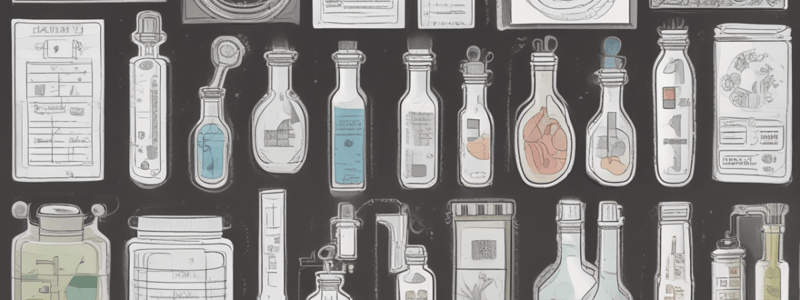Podcast
Questions and Answers
What is the color of the blood tube used for collecting non-anti-coagulated blood samples?
What is the color of the blood tube used for collecting non-anti-coagulated blood samples?
Which type of fluid is collected in a BLUE-topped blood tube?
Which type of fluid is collected in a BLUE-topped blood tube?
What is the purpose of the GREEN-topped blood tube?
What is the purpose of the GREEN-topped blood tube?
Which of the following is NOT a type of fluid collected in a YELLOW-topped blood tube?
Which of the following is NOT a type of fluid collected in a YELLOW-topped blood tube?
Signup and view all the answers
What is the purpose of the GRAY-topped blood tube?
What is the purpose of the GRAY-topped blood tube?
Signup and view all the answers
What is the common issue with SWABS samples?
What is the common issue with SWABS samples?
Signup and view all the answers
What type of blood sampling is associated with a higher risk?
What type of blood sampling is associated with a higher risk?
Signup and view all the answers
Which of the following is a characteristic of the Vacutainer method?
Which of the following is a characteristic of the Vacutainer method?
Signup and view all the answers
What is the primary advantage of POCT compared to other blood sampling methods?
What is the primary advantage of POCT compared to other blood sampling methods?
Signup and view all the answers
What is the typical gauge of needles used for blood sampling?
What is the typical gauge of needles used for blood sampling?
Signup and view all the answers
Which of the following is NOT a type of non-blood laboratory sample?
Which of the following is NOT a type of non-blood laboratory sample?
Signup and view all the answers
What is the typical volume of syringes used for blood sampling?
What is the typical volume of syringes used for blood sampling?
Signup and view all the answers
What is the primary purpose of Urinalysis?
What is the primary purpose of Urinalysis?
Signup and view all the answers
What is the typical fixative used in Histology?
What is the typical fixative used in Histology?
Signup and view all the answers
Study Notes
Blood Samples
- Arterial blood samples can be collected via P.Venipuncture
- Capillary blood samples can be collected via Direct or Indirect methods
- Specialized blood samples have a higher risk and require more invasive procedures
- POCT (Point of Care Testing) blood samples are less invasive and safer
Blood Collection Methods
- Syringe Method: uses slip tip or Luer Lock syringes with various capacities (3, 5, 10, 20, 60 CC)
- Syringe Method: uses needles with different gauges (18, 20, 21, 22, 23, 25) and lengths (1 inch or 1.5 inch)
- Vacutainer Method: uses a double-sided needle and vacuum dependent system
- Vacutainer Method: may result in potentially adequate volumes, but has a high incidence of inadequate volumes
Blood Tubes
- Anti-coagulated blood tubes (Plasma): Gray, Purple, Blue, Green (and others)
- Non-anti-coagulated blood tubes (Serum): Red, Yellow (SST)
Non-Blood Samples
- Urine samples: used for Urinalysis, m/c/s, and 24hr analysis
- Stool samples: used for OBR, OCP, M/C/S, and MAU analysis
- Sputum samples: used for microbiological analysis
- Semen samples: used for microbiological analysis
- Swab samples: used for microbiological analysis (hvs, throat, wound, rectal, etc.)
- Fluid samples: used for analysis (synovial, pleural, CSF, etc.)
- Histology samples: require 10% Formalin
- Cytology samples: require specific preparation and analysis
Studying That Suits You
Use AI to generate personalized quizzes and flashcards to suit your learning preferences.
Description
This quiz covers the different types of laboratory samples, including blood and non-blood samples, with a focus on collection methods and categorization.




